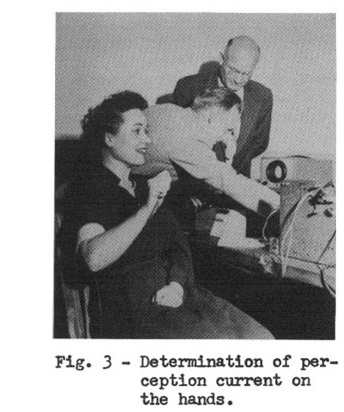A Residual Current Device is designed to protect people against death from electric shock. To do this it must trip at below 30mA and in less than 300ms according to the Australian Standards. But have you ever stopped to wonder why those particular values are chosen for the protection levels?
An Interesting History
 Much of the work we rely on today was first pioneered in the 1950s. A professor from the University of California, Charles Dalziel published the seminal work “Effects of Electric Shock on Man”. This paper was based on extensive research which included testing of human volunteers to determine perception and let go thresholds, as well as tests on animals and animal carcasses for the more risky and damaging shock current values. Charles Dalziel would later go on to patent a voltage dependent Residual Current Device which could work on the lower voltages used in the USA. Much of the work we rely on today was first pioneered in the 1950s. A professor from the University of California, Charles Dalziel published the seminal work “Effects of Electric Shock on Man”. This paper was based on extensive research which included testing of human volunteers to determine perception and let go thresholds, as well as tests on animals and animal carcasses for the more risky and damaging shock current values. Charles Dalziel would later go on to patent a voltage dependent Residual Current Device which could work on the lower voltages used in the USA.
Figure 20 from IEC 60479-1:2018
The thresholds determined have been incorporated into modern standards shown graphically at Figure 20 from IEC 60479-1:2018. This time-current graph shows human sensitivity to AC currents broken down in to 4 main zones .

AC-1: Perception possible but usually no startled reaction
AC-2: Involuntuary muscular contraction but no harmful effects
AC-3: Strong muscular contractions, reversible disturbance to heart function, and difficulty breathing.
AC-4: Possible irreversible effects (ie burns) and risk of ventricular fibrillation
AC-4.1 <5% chance of heart fibrillation
AC-4.2 <50% chance of heart fibrillation
AC-4.3 >50% chance of heart fibrillation
Determining the trip thresholds
We can see from the graph that a trip threshold of 30mA means that the shock current will never enter the zone where it could cause heart fibrillation, regardless of the duration. By also limiting the maximum trip time at 30mA to 300ms, it means that the actual tripping threshold will be below a level where it causes issues to breathing or the heart. For the same reason a current of 5xIDn (ie 150mA) must cause a trip in less than 40ms.
This is the reason the trip thresholds are set at the levels they are.
If you’d like to learn more about RCD technology or standards, please visit our website at https://resources.ipd.com.au/rcd/
|